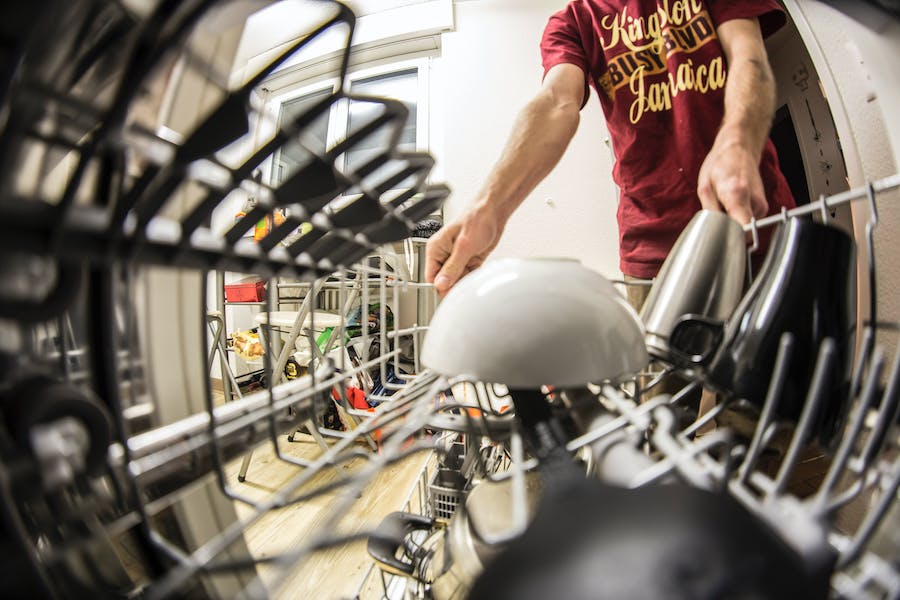The enduring appeal of cast iron cookware is unmistakable, known for its ability to retain and evenly distribute heat, making it a favorite among chefs and home cooks alike. However, a persistent debate revolves around a common question: Can you put cast iron in the dishwasher? This article delves into this contentious issue, aiming to provide clarity and guidance on the proper care of cast iron cookware. By exploring the intricacies of dishwashers, the potential consequences of dishwasher use on cast iron, and expert opinions, we seek to answer whether it’s a good idea to entrust your beloved cast iron skillet or Dutch oven to the machine that cleans our dishes.
Can You Put Cast Iron In The Dishwasher?
No, it is not recommended to put cast iron cookware in the dishwasher. Dishwashers can expose cast iron to harsh detergents, high water temperatures, and aggressive mechanical action, which can lead to rust formation, stripping of seasoning, and damage to the seasoning layer. To maintain the quality and longevity of your cast iron, it’s best to clean it by hand and follow proper care and seasoning practices.
The Basics Of Cast Iron Cookware
Cast iron cookware has a rich history dating back centuries, known for its durability and excellent heat retention properties. This versatile type of cookware has a special place in the hearts of both professional chefs and home cooks. Cast iron is made by melting iron and pouring it into a mold, resulting in cookware that is solid, heavy, and capable of withstanding high temperatures.
One of the most cherished qualities of cast iron is its even heat distribution. When heated, cast iron retains heat effectively and spreads it evenly across the cooking surface. This property makes it ideal for tasks like searing, frying, and baking, as it ensures that food cooks uniformly and develops a delightful crust or texture.
Common types of cast iron cookware include skillets, Dutch ovens, griddles, and more. Each type has its unique features and advantages. For instance, skillets are perfect for frying and sautéing, while Dutch ovens excel at slow-cooking stews and braises. Cast iron griddles are ideal for making pancakes, grilled sandwiches, or even pizza.
Another notable characteristic of cast iron is its ability to retain and enhance the flavors of the food cooked in it. Over time, with proper care and seasoning, cast iron develops a natural non-stick surface that not only prevents sticking but also imparts a subtle richness to the dishes prepared in it.
How Dishwashers Work?
Dishwashers are household appliances designed to automate the process of cleaning dishes, utensils, and cookware. They use a combination of mechanical, thermal, and chemical processes to remove food particles, grease, and stains from dirty dishes. Here’s an overview of how dishwashers work:
Loading: Users load dirty dishes into racks or compartments within the dishwasher. This typically includes plates, glasses, cups, cutlery, pots, pans, and more.
Pre-washing: Many modern dishwashers have sensors and pre-wash features. Sensors detect the level of dirt and food particles on the dishes and adjust the washing cycle accordingly. Some dishwashers also have a pre-rinse cycle, which sprays water to remove loose debris before the main wash.
Detergent Dispensing: Dishwashers have a compartment for detergent, which is usually in the form of powder, liquid, or tablet. The dishwasher releases the detergent at the appropriate time during the wash cycle.
Water Filling: The dishwasher fills its tub with hot water from the household water supply. The water is heated to the desired temperature for effective cleaning, typically between 120°F (49°C) and 160°F (71°C).
Washing Cycle: The dishwasher’s spray arms, typically located at the bottom and top of the dishwasher, rotate and spray hot water onto the dishes. The water, combined with detergent, helps to break down and remove food residues and stains.
Mechanical Agitation: Some dishwashers also have rotating spray arms or water jets in the bottom that provide mechanical agitation to dislodge stubborn dirt. The dishes are continuously sprayed and rotated to ensure thorough cleaning.
Drainage: After the washing cycle, the dirty water is drained out of the dishwasher through a drain pump or a gravity-based system. Some dishwashers have filters or food traps to prevent debris from clogging the drainage system.
Rinse Cycle: Clean water is sprayed onto the dishes again to rinse off any remaining detergent and food particles. This helps to ensure that the dishes are free from soap residue.
Drying: Dishwashers use various methods for drying, including heated air, fans, or a combination of both. Heated air dries the dishes, and fans help to circulate the hot air for faster and more efficient drying.
End of Cycle: Once the washing, rinsing, and drying cycles are complete, the dishwasher signals the end of the cycle, typically with a beep or indicator light. Users can then unload their clean and dry dishes.
Proper Care And Maintenance For Cast Iron Cookware
Proper care and maintenance are essential to ensure the longevity and performance of your cast iron cookware. Follow these steps to keep your cast iron skillets, Dutch ovens, and griddles in excellent condition:
1. Hand Washing:
After cooking, allow the cast iron cookware to cool down slightly but not completely.
Use warm water and a stiff brush or non-abrasive scrubbing pad to gently remove food residue. Avoid using harsh scouring pads or steel wool, as they can damage the seasoning. Avoid using soap if possible, as it can strip the seasoning. If necessary, use a small amount of mild dish soap. Rinse thoroughly to ensure all soap or detergent residue is removed.
2. Drying:
After washing, immediately dry the cast iron cookware with a clean towel or paper towels. To prevent moisture-related issues like rust, ensure that the cookware is completely dry before storing it.
3. Seasoning:
Regular seasoning is crucial to maintaining the non-stick surface of your cast iron cookware and preventing rust. Apply a thin layer of cooking oil, such as vegetable oil or shortening, to the entire surface of the cookware, including the exterior if necessary.
Use a paper towel or cloth to evenly distribute the oil and remove any excess. Place the cookware upside down in an oven preheated to 350-400°F (175-200°C). Bake the cookware for 1-2 hours to allow the oil to polymerize and create a new layer of seasoning. Let the cookware cool in the oven before removing it.
4. Storage:
Store cast iron cookware in a dry place to prevent moisture-related issues like rust.
To prevent scratching, consider placing a paper towel or cloth between stacked cast iron pieces. Store with the lids off or slightly ajar to allow air circulation and prevent moisture buildup.
5. Regular Use:
Regularly cooking with your cast iron cookware helps maintain its seasoning. The natural oils from food contribute to the seasoning’s improvement over time. Avoid cooking highly acidic foods, like tomatoes, for extended periods, as this can erode the seasoning. Gradually build up the seasoning layer by using your cast iron cookware frequently.
6. Seasoning Touch-Up:
If you notice areas with worn or uneven seasoning, you can perform a spot seasoning touch-up. Apply a small amount of oil to the affected area, heat the cookware over low to medium heat, and spread the oil evenly with a paper towel or cloth. Continue heating until the oil begins to smoke, then remove from heat and allow it to cool.
Conclusion
In conclusion, proper care and maintenance are the keys to preserving the exceptional qualities of cast iron cookware. By following the recommended practices of gentle hand washing, thorough drying, and regular seasoning, you can ensure the longevity and performance of your cast iron skillets, Dutch ovens, and griddles. While the dishwasher may offer convenience, it’s best reserved for other kitchen items. With patience and commitment to maintaining your cast iron cookware, you’ll continue to enjoy its even heating, natural non-stick surface, and the delicious meals it helps create for many years to come.
FAQs
1. Can I Use Soap To Clean Cast Iron Cookware?
Yes, you can use a small amount of mild dish soap when necessary. Just be sure to rinse thoroughly and re-season the cookware afterward.
2. How Often Should I Re-Season My Cast Iron?
You should re-season your cast iron cookware whenever you notice the seasoning wearing off or if rust appears. Regular seasoning touch-ups can help maintain its non-stick properties.
3. Can I Use Metal Utensils With Cast Iron?
While it’s best to use wooden or silicone utensils, you can use metal utensils with caution to avoid scratching the seasoning.
4. Is It Safe To Put Hot Cast Iron Under Cold Water?
It’s not recommended to expose hot cast iron to cold water, as sudden temperature changes can cause warping or cracking. Allow it to cool down before washing.
5. Can I Cook Acidic Foods In Cast Iron?
Yes, you can cook acidic foods in cast iron, but it’s advisable not to leave them in the cookware for extended periods, as acids can erode the seasoning.










Leave a Reply